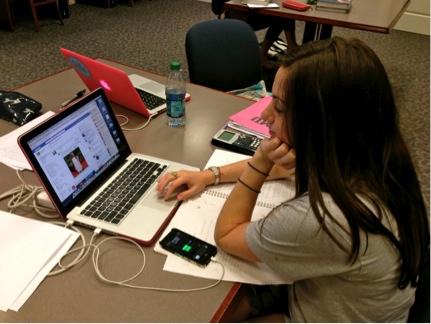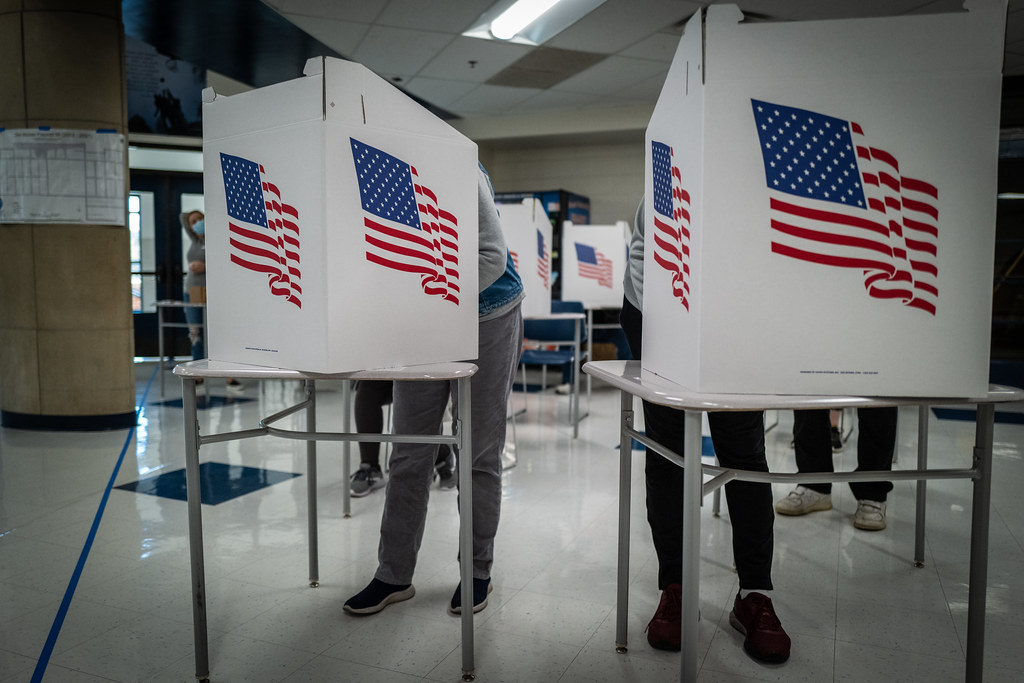
Students in Fondren Library find themselves distracted by social media sites. (SMU/Caroline Hicks)
When SMU sophomore Taylor Goerke walks across campus to class, she scrolls through her phone to check her social media.
“I find myself unable to walk to class without checking my phone for new Facebook notifications or Snapchats,” Goerke says. “One time I actually ran into someone on the boulevard because I was so focused on the new photos I had been tagged in that I wasn’t paying attention to where I was going.”
Students walk around college campuses with their heads down frantically scrolling through photos, newsfeeds and tweets on their iPhones. People stop speaking mid-conversation to pose for a “selfie” to send via Snapchat to a friend across the room.
Social media sites and applications are dominating the social life on college campuses and diminishing any chance at personal, uninterrupted conversation.
“It’s definitely an addiction,” Goerke says. “It started out as an obsession with texting, but as sites like Facebook have popped up on cell phones, it’s a whole new ballgame.”
According to a Pew Research Center study, 67 percent of social media users use Facebook. Students rely on Facebook for the majority of their photo and event updates.
“For younger students, Facebook is the most popular,” SMU Adjunct Professor Steve Lee, who teaches Social Media and Online Communication, says.
Haylee Dawe, a sophomore at Elon University in North Carolina agrees.
“It’s everything,” she says. “It’s a way to be in the know with everything going on with friends at your school, but also at other schools. It helps me keep in touch with friends from all over.”
Lee says younger students overuse social media sites, but older students have learned to manage their use so that it is academically helpful.
Lee’s course teaches students interested in communication how to use social media strategically for business purposes.
“The focus [of the class] is on the strategic role each social media platform and function plays in both internal and external communications for the organization,” he says. “[Students] learn how to write, how to manage various platforms, and how to monitor and evaluate and report results back to senior management.”
SMU sophomore Schuyler Mack already uses social media to advance her business. She uses a “DevouringDallas” account on the popular app Instagram to document her favorite restaurants in Dallas and suggest what food to order. She uploads photos of delicious meals and uses the geographical location capability to tag the restaurant. The account currently has almost 1,744 followers and this number increases daily.
“It’s an easy advertisement…[because] the format is easy to scroll through, you don’t have to navigate to other pages to see more photos,” Mack says.
In a society where instant gratification is everything, Instagram fulfills the needs of college students who want to see everyone’s photos quickly.
“I check Instagram all the time,” Dawe admits. “It’s easy to walk to class and scroll through to see what people are up to, without taking the time to look through individual’s albums on Facebook.”
Instagram, which was recently bought by Facebook, is so popular that apps are copying the format of it.
A new app called Vine allows users to film segments of their surroundings which are then compounded into a short video. The videos are formatted much like the photos on Instagram, where users scroll down one page and see everyone’s posts.
“Vine is a little ridiculous,” Dawe says. “Seeing everyone’s pictures is enough, but now we’re privy to their every action and can see it on our cell phone screens. But even if people think it’s creepy or unnecessary, it will catch on like wildfire, just like the other apps have. Over time it’ll feel like the norm.”
It is this notion that makes these apps so successful and popular on college campuses. Students want to be in the technological know, so once they hear about an advancement, they are likely to want to check it out.
The idea of fast paced socializing applies to the Snapchat app, which also allows users to send a picture that will last from one to 10 seconds and then disappear.
“A picture’s worth a thousand words,” Standard says. “Students are busy but it’s easy to connect on the go with Snapchat.”
The increasing rate of new applications hitting the market means there’s an app to fit every user’s social media style. However, as the rate increases, personal relationships may be suffering.
“Sometimes when I think about it I miss the days when we could have fun with friends without having to stop to document every funny occurrence on Twitter,” Dawe says.
Goerke, however thinks Twitter provides more of a variety to the world of social media.
“I like reading people’s tweets rather than just stalking their pictures,” says Goerke, who counts Twitter as one of her favorite apps. “I catch myself laughing out loud reading people’s thoughts. I don’t think it’s creepy because it’s fun to share hilarious sightings and events throughout the day, as long as you don’t include too much personal information.”
Twitter also serves as a news center for college students. The fast pace nature of the app makes it a good source for learning about the most recent news first. Depending on what users choose to follow, they can read about anything from entertainment news from their favorite celebrity to political news from CNN.
“I get a lot of my news from Twitter and Facebook,” Standard says. “I’m already on it to connect with friends, plus I can learn about what’s going on in the world, so I’m killing two birds with one stone and saving time.”
Sites such as Pinterest and StumbleUpon provide college students with the opportunity to wander mindlessly online through pictures and sites of interest to them. They may pose as a distraction during class.
“It’s really easy to log into Pinterest and then accidentally spend hours at a time pinning cute clothes or scrolling through recipe ideas,” Goerke says. “Most of my classes require a laptop, which means the temptation to Pin during a long lecture is even greater.”
Social media provides students with a wealth of information and the ability to keep up with friends constantly. In this ever-changing society, it’s safe to say these apps aren’t going anywhere and will only be increasing in numbers.
“College students have seamlessly adopted social media use in their personal lives… They have learned how to use it to keep up with friends, family and news,” Professor Lee says.
When asked if sites like Facebook will be around forever, Dawe laughs.
“Yes, of course,” she says. “It has become a way of life for close to every college student. The campus dynamic and social scene would be completely different without it.”








